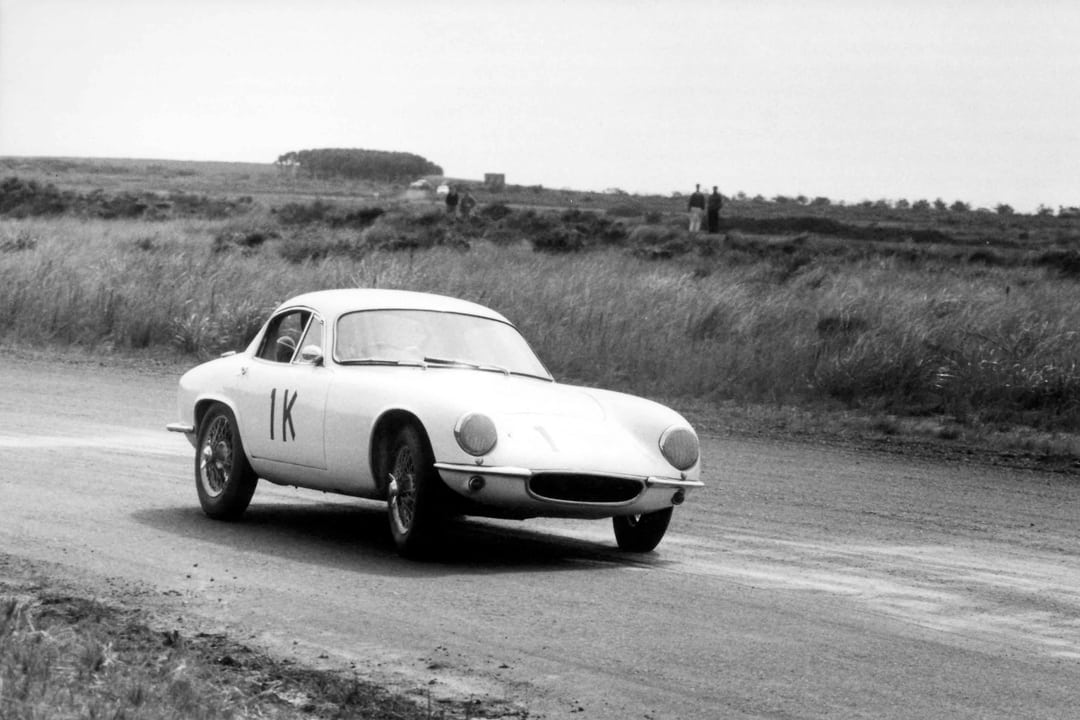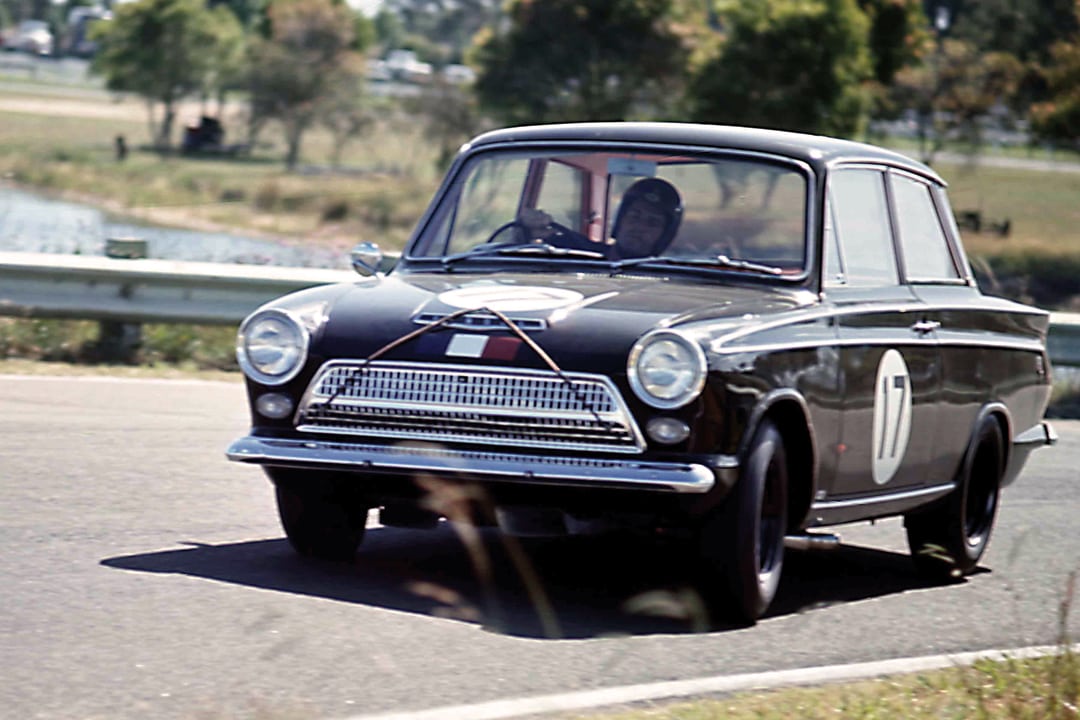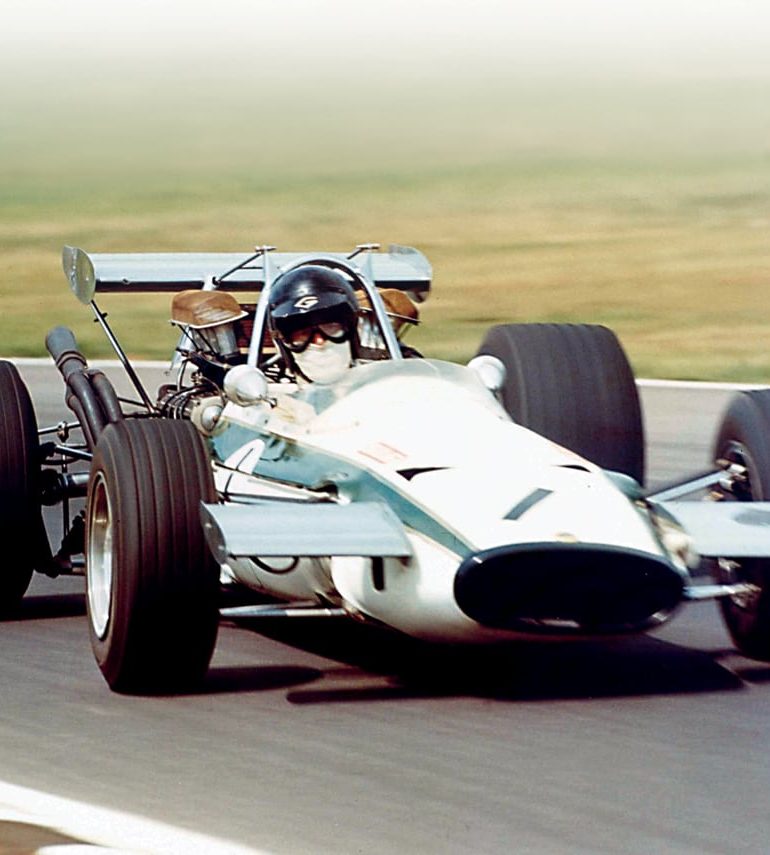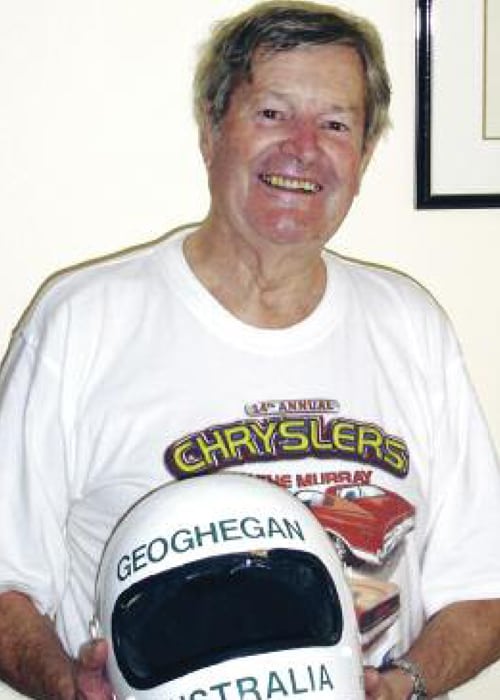During the late 1960s and 1970s, the names of Leo and Ian (aka Pete) Geoghegan became known thoughout almost every household in Australia. In the case of brother Leo, a string of successes in Lotus open-wheelers, back-to-back Australian F2 championships and an Australian Drivers Championship gave him not only Australian, but international notoriety as one of Australia’s leading hot shoes. This month our South Pacific Editor Patrick Quinn speaks with Geoghegan about his very diverse motor sport career and how he got Jim Clark to mow his mother’s lawn!
What started you off in motor sport?
Geoghegan: It was my dad. He had originally run taxis and had a car yard in Liverpool, southwest of Sydney. There was a service station in front, where Pete and I used to pump petrol in the morning before school. Dad used to race motorcycles at Bathurst before the Second World War, prior to the tarring of the circuit. Later after I finished school, I took over the running of the petrol station as Dad wasn’t well, and he eventually sold the taxi business.
Dad bought an MG TC in the middle of the ’50s, took the windscreen and guards off, made up a set of 16-inch wheels and entered it in a race at Bathurst. I remember the race clearly as it was a handicap event with 70 cars running, including 26 MGs on the same handicap. Going down the Dipper, I thought the right-hand front wheel was going to come back and knock his head off. He had already taken the precaution of putting a couple of hooks on the doors so they wouldn’t fly open. The blokes who persevered came up with some pretty elaborate arrangements for the wheels, but the simplest solution was just pieces of wire from the front of the springs so they couldn’t move.
Back then there was next to no communications, as all our information from overseas was a couple of months old. Anyway, Dad saw a couple of Jowett Javelin Specials and thought it was the way to go. So he got to know the blokes who were selling Jowetts. The MG had gone down the straight at 91 mph, which was pretty fast in those days, and had probably gone up at around 50. The first all-sedan car race was held in 1950 at Bathurst, before that they were part of other events. So they got together around 15 cars and Hercules Motors loaned Dad a demonstrator Javelin, which was quicker than a Buick we had at the time. However, the Jowett was a long time getting here, expensive and, in the end, Dad used the chassis and put his own body on it.
By then we were using Holden cabs in the taxi business, so soon a couple of blokes were racing Holdens, and I was busting to go racing. A new Holden was only available in three colors, black, gray and cream. They were perfect for cabs and, while English cars like the Ford Anglia and Triumph Mayflower became available, they were fine for England but not here.
What was your first drive?
Geoghegan: Dad saw something in the newspaper about a 100-mph Holden. It was Jack Myers driving his at the Gnoo Blas circuit at Orange. As a test, Dad said that I could follow him around the circuit in one of the Holdens while he drove the Jowett. I made some remark and in the end found myself in the Jowett while he drove the Holden and came 2nd.
The petrol station was doing well as it was normal for the time that we sold about six different brands with each fuel company proclaiming what marvelous quality their product had. Soon, the oil companies decided to follow the American trend of having one-brand stations. It took a while for people to accept this as many thought it was taking away their freedom of choice. Back then you had to close at 6:00 p.m. as there wasn’t any night trading, plus you weren’t allowed to open until 11:00 o’clock on Sunday morning. Was I glad, as that was my day to work!
I became involved in club motor sport which was held on deserted emergency airstrips. We used to race down one side, around the straw bales and back again. The Australian Racing Drivers’ Club was formed and then the Confederation of Australian Motor Sport. The Australian Sporting Car Club was the leading club in New South Wales, but it was more rally oriented.
What about Bathurst?
Geoghegan: I drove at Bathurst for the first time in 1956 in the Holden. Bathurst was marvelous, all that I expected and more. I loved it! Loved the challenge. To cut a long story short it was a handicap race and we started at the back but managed to win the event with Bob Holden not far behind in a Peugeot.
We kept the Holden until 1960 as there was nothing else to buy. We were into sedan cars and back then the Holden was the way to go until David McKay brought in his 3.4-liter Jaguar. We continued on with another Holden but, eventually, David sold the Jaguar to Ron Hodgson. It wasn’t long before we sold the Holden and ended up buying the Jaguar from Ron for Pete to drive.
Then in 1964 we bought a Lotus Cortina in which brother Pete won the Australian Touring Car Championship.
How did you start out in open wheelers?
Geoghegan: It all came about with our association with Lotuses. I had been driving a Lotus Elite and I managed to win the 1960 Australian GT Championship. Then in 1961, Jamiesons who were a Sydney-based Lotus dealer, imported a Lotus 18 Cosworth Formula Junior which they entered at the international race at Warwick Farm in January for Paul Samuels to drive. Stirling Moss was also entered in a Lotus 18 2.5-liter F1 car but, as it was late being unloaded from the ship, Geoff Sykes of the Australian Automobile Racing Club asked if Stirling could familiarize himself by driving the F-Junior. Eventually, Paul got the car back on Saturday and practiced in a car that he had never driven before.[pullquote]“..for a couple of seconds you were in an airplane instead of a racing car.”[/pullquote]
The same car was entered for a meeting at Catalina Park in February for both Paul and me to share, with both of us winning a race each. Jamiesons entered it again at Warwick Farm for me to drive, and I managed another win. Next was the annual Bathurst Easter meeting where it again was entered by Jamiesons and, after that, we bought the car and entered it in our own name and repainted it in our family black, the same as the Holden. Sadly, Jamiesons eventually went under financially but not before they brought out another two Lotus 18 Formula Juniors.
You moved on very quickly, didn’t you?
Geoghegan: Oh yes! I ended up racing the 18 through the end of 1961 with 9 wins out of 10 starts. By the beginning of 1962, we had become Lotus agents for New South Wales and Queensland, and we soon bought a Lotus 20 for me to drive. That was followed by a Lotus 22 and, looking back, I consider myself to be very fortunate as we just kept on having success after success. That was followed by a Lotus 20B and then, in 1963 along with Arnold Glass and Glyn Scott, we all bought Lotus 27s.
We managed to obtain an ex–Jim Clark Lotus 32 Climax in 1964 and ran that in the 1965 Tasman Series and through the following year with a Ford engine. The 1966 Series was the real bonus as Lotus shipped a 39 Climax out for Jim to use and after the Series, we bought it.
I have said it before that the Lotus 39 was the nicest open-wheeler I drove through my career. We kept the Climax engine for 1967 and then fitted one of the first Repco V-8s for the next year. Although I will say that we did have quite a few problems with the engine to start with, so much so that Repco ended up giving us and David McKay new cylinder blocks. We ran it with the Repco engine again in 1969, the last year of the 2.5-liter Tasman formula.
That year was very successful for me and the 39 as we were invited to Japan for the JAF Japan Grand Prix at Fuji, which I won with Kiwi Roly Levis coming in 2nd. I went back in 1970 for the same event with a Lotus 59 fitted with an Australian-made Waggott Twin Cam engine but only managed 6th some three laps behind Jackie Stewart’s Brabham.
What was your most memorable period of motor sport, Leo?
Geoghegan: Most definitely it was the 2.5-liter Tasman Series between 1964 and 1969. I did my first Tasman event at Pukekohe, New Zealand, in 1965 in the Lotus 32, but at the beginning never did the whole 8 races, just a couple in New Zealand followed by all the Australian events. We had a marvelous time because once a year we got a chance to race against the best blokes in the world, and you would learn a great deal. I soon found out that not only did we have the opportunity to compete against some of the best blokes but you could also defeat some of those blokes as well. It was nice back at the 1969 AGP at Lakeside to come 3rd behind the two works Ferraris of Amon and Bell with Graham Hill’s Lotus behind me. That was a real buzz.
Probably the day I came 2nd to Jim Clark at Sandown in 1967 was the highlight. However, when I’m asked what was my very favorite car of all the 64 cars I raced in my career, I usually answer that it was actually my old black, early-model FX Holden, my very first car that I raced close on to 50 years ago. I recall—as if it were just yesterday—when I first went to Bathurst and won the very first race I had entered.
I can recall watching you run the Lotus 39 at Bathurst in 1970 and you were very quick indeed.
Geoghegan: The 39 was a pretty nice car and I loved Bathurst, but I soon found out that there is a quick way around Bathurst and there is also a hard way. I found the quick way, which was good as the track wasn’t too flash back then and a bit bumpy. In the Lotus 39 Repco, we were doing 300 kph or around 180 mph down the straight over those humps. So, for a couple of seconds you were in an airplane instead of a racing car. Anyway, I survived all that. The car started life with a Climax engine and was one of the first cars in Australia fitted with a Repco V-8.
It was a pretty car and we had it painted white, but it’s nice to see it back in the same Lotus colors of when Jim Clark drove it. However, I only wish it were still in my shed.

Photo: Autopix.com.au
During the Tasman there was plenty of time to have fun as the mechanics did most of the work. I remember going to Chris Amon’s place in New Zealand to play cricket with the other drivers. However, I reckon the best fun was here in Australia. My family home had quite a big yard with a lovely garden and we would always have a party on the Sunday night after most race meetings but especially after the Tasman races at Warwick Farm. We were also quite happy for any team to use our workshop.
There was one year I recall with Jimmy Clark spending a lot of his time out here at Bankstown Aerodrome learning how to fly. So we didn’t see that much of him, but there was once when he arrived at the workshop one afternoon and was standing around as if he had nothing to do. Everyone else was very busy and then the phone went and it was my mum. She said that the lawn needed mowing to get everything ready for Sunday night’s festivities. I told Mum that everyone at the workshop had their heads down and bums up doing things. Then Jim walked into the office and I asked him if he had anything to do. He said, “No!” So I asked him if he wouldn’t mind mowing my mother’s lawn for Sunday night’s barbie!
So we had a world champion mowing my mother’s lawn. Mum didn’t know him but I understand later from her that he knocked on the door and said, “Hello, I’m Jim. Leo asked me to mow the lawn.” Mum just said, “Right, Jim. There’s the mower; away you go.” I told my mum later who Jim was.
There was another night after Sandown and, following each race, we used to have a good time. This particular time, which must have been 1967, because Jim was still alive. Most of the people were staying in the same motel. It was back in the days when whoever got pole position would receive 100 bottles of champagne, and also during the meeting they had a novelty race in Ford Cortinas for all the drivers with first prize of another 100 bottles of champagne. So, on the Sunday night, all the champagne was at the same motel.
On hot race days you would tend not to eat but make up for it later. So, we managed to demolish 200 bottles of champers, which of course made us all very secondhand the next morning. The motel had shag pile carpets, which was quite a novelty then, and Jim was running up and down making motor noises pretending to mow the carpet. Normally, Jim was a very quiet bloke, but his mate Graham Hill was very much the opposite.
While Jim was mowing the carpet, Graham Hill was walking along the roof of the motel with an umbrella up pretending to be a tightrope walker. My brother had the water hose out and was hosing him down. It would have been a bit of a tragedy if the world champion fell off the roof and broke his leg. But we survived all that and, thinking back, they were marvelous days.
What was the racing like the next week?
Geoghegan: It was pretty busy because the Tasman was busy as there were eight race meetings in eight weeks and in two countries. We just didn’t have a big enough team to take it all on, so we’d do two in NZ and come home to get ready for the four rounds in Australia. I love NZ and I am about to have a holiday there to catch up with my mates while we are still all breathing, and I’m looking forward to driving around without a racing car on the back.
Did you have any favorite circuits?
Geoghegan: As far as circuits goes in Australia, there were ones I didn’t like. With respect to the ARDC, I didn’t like Amaroo Park because the original design was for a time when the cars were much slower, meaning that the corners were also slow. I thought it was a dangerous circuit.
Longford in Tasmania was marvelous with 4-1/2 miles around. You went down a hill, under a railway viaduct, over a river on a wooden bridge, then you drove around the Longford Hotel corner and over the railway line that, just 200 yards beforehand, you went under. Down the back straight very quickly onto another wooden bridge and onto the main straight that was over a mile long. All great stuff. The back straight was a bit dodgy as it was narrow but very fast that wove in and out of clusters of trees. So, normally you would hold the steering wheel in the straight-ahead position, however if the wind was blowing as you came past some trees, you would have to put on almost half a lock just to keep the car straight. You were always deep in concentration going down that road.
I remember one year I was there and I think I was on the second row. I said to Jim and the other drivers, “Look, fellas, just in case one of you guys makes a crook start and I make a good one, I’ll get out of your way, but I can’t get out of your way going down the back straight.” I said that I needed the middle of the road because the car was moving around all over the place in the wind. Nearly all of them said, “Mate, we have no intention of even thinking about passing you down there.” They were all in the same boat.

Photo: Autopics.com.au
The funny thing was that we got to the end of the straight and everyone was very well behaved, going very fast but, when we came to the braking area coming onto the long bridge, suddenly they were four wide instead of being in single file. They were amazingly competitive. They were the champions of the world. You would have thought there was a million dollars in prize money for the first bloke to get over the bridge.
We learned a lot from them. Plus you don’t learn from being out in front…perhaps a bit. But you learn a lot from someone who is quicker than you, so you have a look and find out why, and say to yourself, “I’ll try that!” Of course, the other opportunity we had was to buy last year’s cars they had brought with them from England plus, by getting to know the mechanics, we found out all sorts of new technical information. It was a highlight of living in Australia during the 1960s, as it was a lovely place to live and a lovely place to be a racing driver.
For many years Leo and Ian Geoghegan continued to operate Geoghegan’s Sporty Cars not far out of the Sydney, CBD. Leo was a driver that could turn his hand to most vehicles and, during the late 1960s, partnered his brother behind the wheel of sedans in the annual Bathurst 500. Sadly, Ian (Pete) Geoghegan died a few years back, but Leo now lives in gentle retirement on the outskirts of Sydney. However, he maintains a strong interest in motor sport and is frequently seen at historic race meetings where he is usually surrounded by enthusiastic fans seeking his autograph, opinions or even the occasional interview.





